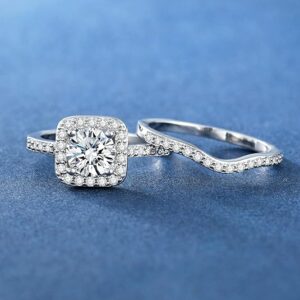Ever wondered if diamonds can be grown like plants?
Well, guess what—they actually can. And no, this isn’t science fiction. It’s real, and it’s reshaping how people shop for engagement rings, gifts, and even heirloom jewelry.
These sparkling beauties are called lab-grown diamonds, and they’re just as stunning, just as sparkly, and just as real as diamonds from deep underground.
Table of Contents
What is a Lab-Grown Diamond?
Let’s keep it simple.
A lab-grown diamond is a diamond that’s made in a laboratory instead of being dug out of the earth. But here’s the important part:
- It’s not fake.
- It’s not a knockoff.
- It’s 100% a diamond—just created in a high-tech environment instead of nature.
In fact, even professional jewelers need special tools to tell the difference. Chemically, physically, and visually—lab-grown diamonds are identical to mined diamonds.
Are Lab-Grown Diamonds Real Diamonds?
Let’s clear up one of the biggest misconceptions right now:
Yes. They are real.
They’re not cubic zirconia. They’re not crystals. They’re not glass.
Lab-grown diamonds are made of carbon atoms arranged in exactly the same structure as a natural diamond. The result?
- Same hardness
- Same brilliance
- Same fire and sparkle
They’re even graded and certified by the same gem labs that grade mined diamonds, like GIA and IGI.
Why Do People Choose Lab-Grown Diamonds?
Let’s break it down:
- Affordability: Get a bigger, better-looking diamond for less money.
- Ethics: No harm, no conflict—guilt-free sparkle.
- Sustainability: Made in labs, not mines—safer for the planet.
- Beauty: Same look, same shine—often even clearer than natural ones.

How Are Lab-Grown Diamonds Made?
Lab-grown diamonds aren’t magic—they’re made using advanced technology that mimics the natural processes that happen deep in the earth. There are two main methods for creating these diamonds:
HPHT (High Pressure High Temperature)
The HPHT method is one of the oldest and most widely used techniques for growing diamonds. It works by replicating the natural conditions that diamonds experience deep underground, where high pressure and temperature turn carbon into a diamond.
How It Works:
- A carbon material (like graphite) is placed inside a special machine.
- It’s then exposed to extreme heat (over 1,500°C) and huge pressure (1.5 million psi)—just like inside the Earth.
- These intense conditions force the carbon atoms to bond together into a diamond crystal.
The process takes a few weeks, depending on how big the diamond will be.
CVD (Chemical Vapor Deposition)
The CVD method uses a gas mixture of carbon (usually methane) and hydrogen. The gases are heated up in a chamber, and when the gas breaks down, carbon atoms attach themselves to a small diamond seed and slowly build up into a diamond.
How It Works:
- A small diamond seed is placed in a sealed vacuum chamber.
- The chamber is filled with carbon gases (like methane) and hydrogen.
- The gases are heated to high temperatures, making them break apart.
- Carbon atoms from the gas stick to the diamond seed and slowly grow into a bigger diamond.
It usually takes 1 to 3 weeks, depending on how big the diamond will be.
What Are Lab-Grown Diamonds Made Of?
Lab-grown diamonds are made from carbon—the same element that natural diamonds are made from.
The difference lies in the way the carbon atoms are arranged, but whether they’re grown in a lab or formed over millions of years underground, they both have the same chemical composition.
In short: Carbon + Time + Pressure = Diamond

Lab-Grown vs Natural vs Fake Diamonds
Ever looked at a diamond and wondered, “Is this natural, lab-grown… or not even real?”
Let’s break it down in the easiest way possible using 9 key points.
What They’re Made Of
- Lab-Grown: 100% real carbon—just like natural diamonds. Grown in a lab, not mined.
- Natural: Also pure carbon. Formed naturally over billions of years under the Earth’s crust.
- Fake: Not carbon. Usually made of cubic zirconia (CZ)—it looks sparkly but isn’t a real diamond.
Where They Come From
- Lab-Grown: Created in high-tech labs using science (no mining involved).
- Natural: Mined from deep underground. Often from Africa, Russia, or Canada.
- Fake: Mass-produced in factories.
Do They Look the Same?
- Lab-Grown vs Natural: Yes—they’re identical in sparkle, clarity, and color.
- Fake Diamonds: Can look close, but often have a glassy or too-perfect look. They lack the fire and brilliance.
How Much Do They Cost?
- Lab-Grown: About 30–50% cheaper than natural diamonds of the same quality.
- Natural: The priciest option because they’re rare and mined.
- Fake: Super affordable. A big CZ (Cubic zirconia) ring could be under $50.
How Do They Sparkle?
- Lab-Grown & Natural: Both have that signature diamond brilliance—white sparkle with fire.
- Fake: Has less brilliance and may look glassy. It can lose its sparkle and get dull over time.
Pro tip: Sparkle is one of the easiest ways to spot a fake.
Resale Value
- Natural: Holds more value over time. Especially true for rare stones.
- Lab-Grown: Lower resale value since supply is growing and price keeps dropping.
- Fake: Almost zero resale value.
Tip: If you see your diamond as a forever piece, resale might not matter much!
How Hard Are They?
- Natural & Lab-Grown: Both score 10 on the Mohs scale—super durable for daily wear.
- Fake: Softer—CZ is around 8. It scratches easier and doesn’t last as long.
Ethics and Sustainability
- Lab-Grown: No mining. More ethical. Eco-friendlier but may still use energy-intensive machines.
- Natural: Mining can impact the environment and involve ethical concerns (unless it’s a certified conflict-free diamond).
- Fake: No ethical concerns, but also no long-lasting value.
Certification
- Lab-Grown Diamonds: Certified by trusted labs like IGI or GIA with full grading reports.
- Natural Diamonds: Certified by gem labs like GIA, AGS
- Fake Diamonds: Usually not certified; most don’t come with any grading report.
Final Takeaway
- If you want a real diamond without the high price or ethical baggage, lab-grown is a smart pick.
- If you’re all about rarity, resale, and tradition, natural might be for you.
- And if you’re just looking for something budget-friendly and sparkly, a CZ will do the job—for a fraction of the price.
| Category | Lab-Grown Diamonds | Natural Diamonds | Fake Diamonds (CZ) |
|---|---|---|---|
| What They’re Made Of | 100% carbon, grown in labs | 100% carbon, formed underground | Not carbon |
| Where They Come From | Made in high-tech labs | Mined from Earth (Africa, Canada, Russia) | Factory-made |
| Do They Look the Same? | Yes—identical to natural | Yes—same as lab-grown | Close, but often glassy or too perfect |
| Cost | 30–50% cheaper than natural | Most expensive (rare & mined) | Very cheap (under $50) |
| Sparkle | White brilliance with fire | White brilliance with fire | dulls over time |
| Resale Value | Low (price keeps dropping) | Higher value, especially rare stones | Almost none |
| Hardness (Mohs Scale) | 10 — very durable | 10 — very durable | 8 |
| Ethics & Sustainability | Eco-friendlier, no mining | Mining impact, ethical concerns | Ethical, but no real value |
| Certification | Certified (IGI, GIA) | Certified (GIA, AGS) | Usually not certified |
Pros and Cons of Lab-Grown Diamonds
Lab-grown diamonds are real diamonds—but are they right for you? Let’s break down the pros and cons in a clear, simple way.
Pros
- More Affordable: You can save 40–50% compared to natural diamonds. Bigger sparkle for less money!
- Eco-Friendly: Lab-grown diamonds create far less pollution and damage than mining. Use 95% less water,Emit up to 98% less carbon,No deforestation or heavy land disruption
- Conflict-Free: No links to war zones or unethical labor. Always a clean, guilt-free choice.
- High Quality: Fewer flaws and more clarity. Many lab diamonds are even purer than mined ones.
Cons
- Lower Resale Value: Lab diamonds usually don’t hold their value well over time.
- High Energy Use (Sometimes): Some labs still use a lot of electricity, especially with older methods. New tech is improving this.
- Less Traditional: Some people prefer natural diamonds for their history, symbolism, or emotional meaning.
Bonus Eco Facts (Quick Stats)
- Water Used: Mined – 126 gallons vs. Lab-grown – under 5 gallons
- CO2 Emissions: Mined – 125 tons vs. Lab-grown – 1.5 tons
- Land Damage: Mined diamonds displace over 250 tons of earth per carat

Frequently Asked Question's
Yes, lab-grown diamonds are real diamonds. They have the same chemical, physical, and optical properties as natural diamonds—only the origin is different.
Yes, they have value, but usually less resale value than natural diamonds. Their worth is based on size, cut, clarity, and certification—just like mined diamonds.
Not by the naked eye. But with special equipment, a trained jeweler or lab can detect the difference between natural and lab-grown diamonds.
They’re also known as:
- Lab-created diamonds
- Man-made diamonds
- Engineered diamonds
- Cultured diamonds
Yes! Just like natural diamonds, lab-grown diamonds are extremely durable and will last forever with proper care.
Some people:
- Value the rarity and tradition of natural diamonds
- Worry about lower resale value
- Are unsure about the technology or energy use
No. Cubic zirconia (CZ) is a diamond simulant, not a real diamond. Lab diamonds are real diamonds, CZ is a cheaper, fake alternative.
The best clarity is “Flawless (FL)” or “Internally Flawless (IF)”, but VS1–VS2 (Very Slightly Included) offer excellent quality at better prices.
It’s a lab-grown diamond that’s been graded and certified by a gemological lab like GIA, IGI, or GCAL for quality (cut, color, clarity, carat).
Final Words: Should You Choose One?
Lab-grown diamonds are real, stunning, and eco-conscious—great if you care about budget and sustainability.
If tradition or resale matters more to you, you might lean toward a natural stone.
The right diamond? It’s the one that feels right for you.
What Do You Think?
- Would you choose a lab-grown diamond for your engagement ring?
- Which matters more to you—price, ethics, or tradition?
Drop your thoughts in the comments below—we’d love to hear from you!



